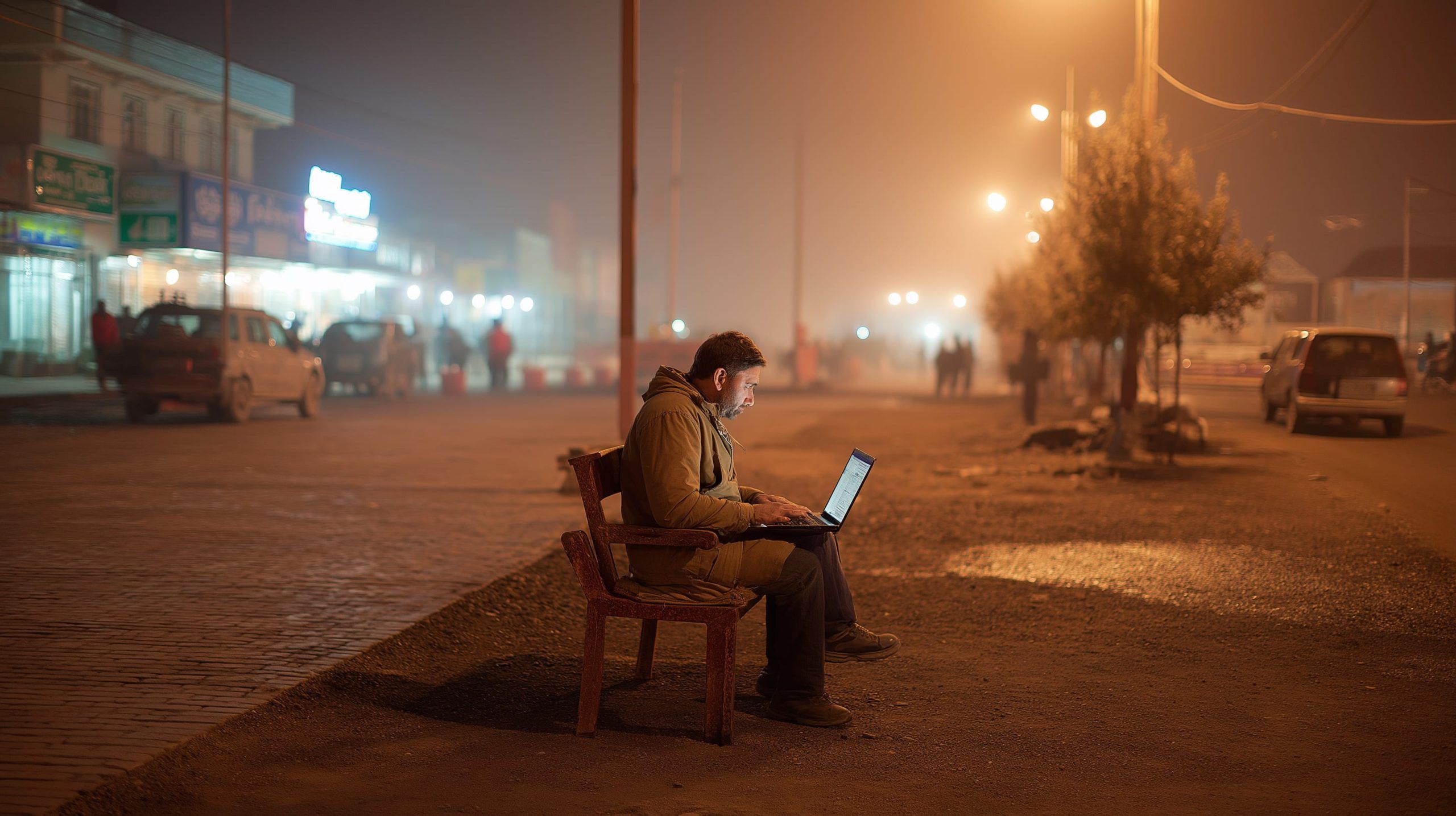- Since 2016, Tajikistan requires all ISPs to route international traffic through the state-controlled Single Communications Gateway via EKTs, enabling surveillance and censorship.
- Fixed-line broadband penetration is effectively zero, with about 6,000 fixed broadband subscriptions nationwide (roughly 0.07% of the population) as of 2025.
- Mobile internet dominates, with 10.54 million active mobile connections by early 2024 (about 102.9% of the population) and 4G coverage reaching roughly 72% of people by end-2022.
- Tajiktelecom monopoly on international bandwidth; in 2018 the government deprived ISPs of the right to buy international bandwidth from abroad, forcing purchases from Tajiktelecom at inflated prices, with bandwidth sold around $53,000 per Gbps in 2019.
- Tcell launched a 5G pilot in Dushanbe in August 2020, ZET-Mobile switched on 5G test base stations in 2021, and MegaFon Tajikistan rolled out commercial 5G in parts of Dushanbe.
- The internet remains expensive, with the 2024 average mobile data price at $1.65 per GB (ranking 142nd of 238 globally), versus Kyrgyzstan at $0.17/GB, Uzbekistan at $0.30/GB, and Kazakhstan at $0.41/GB.
- The government has repeatedly blocked access to Facebook, Twitter, YouTube, and independent news sites during unrest, and the 2015–2017 amendments legalized internet shutdowns without a court order.
- The World Bank’s Digital Foundations Project, approved December 2024 with $39 million, aims to connect at least 100 rural schools and provide digital skills training for 28,000 people between 2024 and 2028.
- In March 2025, the EU/SES Team Europe project will invest €60 million to deploy satellite broadband via SES’s O3b mPOWER to about 1,600 villages across Central Asia, including Tajikistan, reaching about 3 million people by 2025–2028.
- The satellite option is expanding, with Starlink discussions in July 2025 to bring high-speed satellite internet (50–150 Mbps) to Tajikistan once licensing is secured, and Starlink currently operates a constellation of about 7,800 satellites.
Current Internet Infrastructure in Tajikistan
Tajikistan’s internet infrastructure remains underdeveloped, with fixed broadband virtually nonexistent and mobile networks serving as the primary mode of access. Fixed-line broadband penetration is among the lowest in Central Asia – only about 6,000 fixed broadband subscriptions nationwide (roughly 0.07% penetration as of 2025). In practice, home internet via DSL, cable, or fiber is extremely limited to major urban areas. The national incumbent Tajiktelecom (Tojiktelecom), a state-owned operator, has a modest fixed-line network, but most households still lack any wired connection. Instead, mobile broadband dominates: as of early 2024 Tajikistan had 10.54 million mobile cellular connections, exceeding the population (about 102.9% penetration). Four major mobile operators – Tcell, MegaFon Tajikistan, ZET-Mobile, and Babilon-Mobile – provide GSM/3G/4G coverage in populated areas, and all have been rolling out 4G LTE over the past few years. By the end of 2022, 4G network coverage (by population) had reached roughly 72%, up from about 60% a year earlier. This still leaves many rural and mountainous regions with only 2G/3G service or no signal at all, highlighting the urban-rural gap.
High-speed fiber-optic infrastructure exists primarily in backbone links between cities and international gateways. Tajikistan has cross-border fiber optic cables connecting to Uzbekistan, Kyrgyzstan, and Afghanistan, which form the country’s links to the global internet. However, the domestic fiber backbone is limited, and even in the capital Dushanbe, fiber-to-the-home is rare. Only recently have private operators started modest fiber deployments – for example, in 2023 Tcell launched a GPON fiber broadband service in parts of Dushanbe. Fixed wireless and WiMAX solutions are also used in some locales to provide home internet, but overall fixed broadband penetration is effectively near zero. The overwhelming majority of Tajikistan’s 4.25 million internet users (41.6% of the population) access the web via mobile networks or public Wi-Fi hotspots. The table below provides a snapshot of Tajikistan’s connectivity indicators:
| Indicator (Jan 2024) | Value |
|---|---|
| Population | 10.24 million |
| Internet users | 4.25 million |
| Internet penetration | 41.6% of population |
| Active mobile connections | 10.54 million |
| Mobile penetration | 102.9% of population |
| Median mobile download speed | 9.35 Mbps |
| Median fixed broadband speed | 26.84 Mbps |
Table: Key Digital Connectivity Stats for Tajikistan (2024). Median speed data from Ookla Speedtest.
Despite the presence of multiple telecom operators, Tajikistan’s infrastructure struggles to keep pace. Mobile network quality ranks low globally – in February 2025, Tajikistan placed 139th of 143 countries for mobile internet speed, and 118th of 154 for fixed broadband speed. The average mobile download speed was reported under 10 Mbps, and fixed broadband averaged ~33–34 Mbps, far below global averages. Limited investment, difficult mountainous geography, and an impoverished economic environment have all constrained infrastructure development. Maintaining telecommunication lines in remote mountain regions is both technically challenging and expensive. As a result, large swathes of rural Tajikistan rely on outdated networks or remain offline entirely, awaiting better connectivity solutions.
Government Policies and Regulation of Internet Access
Government policy plays a defining role in Tajikistan’s internet landscape – often hindering accessibility and freedom. Since 2016, authorities have enforced a “Single Communications Gateway” that funnels all international internet traffic through the state-run Tajiktelecom. President Emomali Rahmon’s government established the Unified Electronic Communications Switching Center (EKTs) to centralize all telephone and internet communications under state control. By law, all ISPs and mobile operators must route their traffic through this single state-controlled gateway, ostensibly for national security and counterterrorism monitoring. In effect, this gave the government a chokehold over the internet – enabling pervasive surveillance and easy censorship of online content. Amendments to anti-terror laws in 2015–2017 legalized shutting down the internet or blocking communications without a court order during security operations. Indeed, authorities have repeatedly ordered nationwide internet blackouts or social media blocks during periods of unrest or protest. For example, access to Facebook, Twitter, YouTube, and independent news sites has been disrupted “several times in recent years” whenever opposition groups planned rallies or when security forces carried out operations. Officials routinely attribute these outages to “technical problems,” but it is widely understood they are deliberate controls.
Censorship is extensive. Critical news websites, independent media portals, and major social media platforms are frequently blocked in Tajikistan. The government’s control of the sole internet gateway allows it to ban “undesirable” sites for all users at once [1]. According to Freedom House, authorities “routinely block critical websites, news portals, and social media platforms, while using periodic wholesale blackouts of internet and messaging services to suppress criticism.”. Popular services like Radio Free Europe/Radio Liberty, Asia-Plus (a local independent news site), and Pamiri community sites have been intermittently or permanently blocked. Nearly all major social networks are either restricted or closely monitored. A 2017 law even allows authorities to punish citizens for visiting banned websites and mandates monitoring of online behavior. Surveillance is pervasive – the government monitors internet traffic and has prosecuted online critics under extremism laws. In one case, a man was arrested in 2023 for an “extremist” post on social media complaining about local officials; simply voicing dissent online can lead to detention.
Beyond censorship, the state exerts regulatory and economic control. The Communications Service (the telecom regulator) has historically been headed by a close relative of President Rahmon, reflecting politicized oversight. Licensing requirements are strict – ISPs and telecom operators must obtain permits from authorities that can be revoked if they displease the regime. The government has also used taxation and fees to squeeze the telecom sector. For instance, a special excise tax on mobile services was introduced in 2010 (initially 3%, later 5%), contributing to higher consumer prices. In 2018, the government deprived local ISPs of the right to purchase international bandwidth from abroad, forcing them to buy wholesale internet only from Tajiktelecom at inflated prices. This monopoly on bandwidth has strangled competition and given Tajiktelecom “a suffocating degree of leverage” over private ISPs. Tajiktelecom’s wholesale pricing remains a “trade secret,” but in 2019 it was selling bandwidth at around $53,000 per Gbps, far above market rates. (By comparison, a few years prior ISPs could buy bandwidth from neighboring Kyrgyzstan or Uzbekistan for only $10,000–$20,000 per Gbps.) This policy-driven cost increase has had a direct impact on end users through higher prices or reduced service quality.
State ownership and control are also evident in infrastructure. Tajiktelecom, the national carrier, not only operates the international gateway but also owns significant stakes in some telecom ventures (for example, it holds 25% of the mobile operator MegaFon Tajikistan). The government can leverage this influence to steer the market. Under these conditions, the internet in Tajikistan is effectively “not free” – Freedom House consistently rates it among the most repressive environments, similar to Turkmenistan. Press freedom indexes rank Tajikistan near the bottom globally, reflecting the regime’s intolerance of independent online media and strict information controls. Self-censorship is common, as journalists and bloggers face harassment, arrests, and prison sentences if they criticize authorities online. In summary, government policies – from the centralized gateway and licensing regime to censorship laws – have created an internet ecosystem characterized by monopolization, surveillance, and restricted freedoms, which in turn hamper the growth and openness of Tajikistan’s connectivity.
Key Internet Service Providers and Mobile Operators
Despite heavy state influence, Tajikistan’s telecom market does have several active operators, led by a handful of mobile network companies. Mobile services are the main avenue of internet access, and there are five principal mobile operators in Tajikistan:
- Tcell – The largest mobile operator in the country. Tcell originated from the merger of Indigo Tajikistan’s north and south operators in the early 2000s. TeliaSonera (Sweden/Finland) owned a majority stake until 2017, when the Aga Khan Fund for Economic Development (AKFED) purchased 100% of Tcell for $27.7 million. Today Tcell is wholly AKFED-owned and has the widest geographic coverage. It was also an early leader in new technology – Tcell launched one of Central Asia’s first 5G test networks in Dushanbe in August 2020. Tcell offers 2G/3G/4G nationwide and limited 5G hotspots in the capital.
- MegaFon Tajikistan – Branded as such since 2001, this operator is a joint venture of Russia’s MegaFon (which holds 75% through its subsidiary TT-Mobile) and Tajiktelecom (25%). MegaFon Tajikistan is a major player known for relatively fast mobile internet in urban areas. It has invested in network upgrades and, along with Tcell, launched commercial 5G service in parts of Dushanbe (initially in pilot zones). MegaFon’s Russian backing provides access to expertise and capital, but the company operates under local regulations and in partnership with the state via Tajiktelecom.
- ZET-Mobile – Formerly Beeline Tajikistan, this operator entered in 2006 via Russian VimpelCom’s subsidiary. After facing tax and regulatory pressure, VimpelCom (VEON) sold its 98% stake in 2018 to its local partner – the remaining 2% owner – making ZET-Mobile fully locally owned. The brand was re-launched as ZET-Mobile in 2019. ZET-Mobile provides GSM/3G/4G services and reportedly also switched on 5G test base stations in 2021 (offering 5G at a few locations in Dushanbe). With the exit of its foreign investor, ZET is now a domestic company, possibly linked to interests close to the government. It remains one of the top three operators by subscribers.
- Babilon-Mobile (Babilon-T) – The first national private telecom operator, founded in 2000. Babilon is a Tajik-owned company (part of the Babilon group) that operates a mobile network and also provides ISP services. It offers 2G/3G/4G mobile coverage concentrated in cities and towns. Babilon was an early pioneer but has a smaller market share compared to Tcell or MegaFon. The company also runs Babilon-Online, an ISP offering fixed wireless and some fiber connectivity in Dushanbe. Babilon has not yet launched 5G, focusing instead on expanding 4G and value-added services.
- O! Mobile (TK Mobile) – A newcomer launched in October 2020, O Mobile is the smallest operator in the market. It is effectively an MVNO/startup that leases network infrastructure from Tcell to provide its services. O Mobile’s general director is a former Tcell employee, and the company targets niche segments with tailored plans. Its presence is still limited, and it does not operate its own extensive tower network. (Note: confusingly, “O!” is also the brand of a Kyrgyz operator; the O Mobile in Tajikistan is a separate local venture.)
Tajiktelecom itself, while primarily a fixed-line operator, also had a mobile service arm (sometimes referred to as TK Mobile). However, it is not a major consumer brand and largely functions to support the telecom infrastructure and government usage. Tajiktelecom’s significance lies in owning the fiber backbone, international gateway, and being a wholesale provider to the other ISPs.
Overall, the ISP market beyond these mobile companies is small. There are around 22 active autonomous networks (ASNs) in Tajikistan – indicating only a few significant ISPs beyond the mobile operators. The major ISPs cited are Tajiktelecom, Babilon, and Tcell (which also provides fixed wireless broadband). A handful of smaller ISPs and internet cafes exist, often reselling capacity. Many of the private ISPs that once operated have been squeezed out or subsumed under the big players due to the state’s monopoly on bandwidth and high costs. As a result, the telecom market is “small and somewhat saturated with a few dominant players,” lacking robust competition. The table below summarizes the main providers:
| Provider | Type | Ownership | Notable Facts |
|---|---|---|---|
| Tajiktelecom | Fixed-line & Backbone; Mobile (minor) | State-owned (government) | Operates national fiber backbone and the single gateway (EKTs); monopoly wholesale provider. Owns 25% of MegaFon Tajikistan. Provides some DSL/leased-line services in cities. |
| Tcell | Mobile (2G/3G/4G/5G) | AKFED (Aga Khan Fund) – 100% | Largest mobile operator by coverage and users. Launched 5G pilot in 2020. Offers GPON fiber broadband in Dushanbe (since 2023). |
| MegaFon Tajikistan | Mobile (2G/3G/4G/5G) | MegaFon (Russia) 75%, Tajiktelecom 25% | Second-largest operator. Active since 2001; strong in urban markets. Introduced commercial 5G in Dushanbe (with VoLTE services). Russian-backed expertise. |
| ZET-Mobile | Mobile (2G/3G/4G/5G) | 100% local (formerly VEON/Beeline) | Rebranded from Beeline in 2019. Launched limited 5G in 2021. Subject to local market pressures after foreign exit. |
| Babilon-Mobile | Mobile (2G/3G/4G); ISP | Local private (Babilon CJSC) | Oldest private operator (founded 2000). Offers mobile and fixed wireless internet. No 5G yet. Historically innovator, but now a mid-tier player. |
| O Mobile | Mobile (2G/3G/4G via lease) | Local startup (since 2020) | Leases Tcell network infrastructure. Small subscriber base, targeting specific user niches. |
Table: Major Telecom Operators in Tajikistan. (Sources: Asia-Plus report and company info)
Despite multiple operators, true competition is limited. The market has a history of high concentration and even collusion. For example, the Antimonopoly Agency at one point set identical mobile internet tariffs for all operators – indicating coordination in pricing. All providers must obtain bandwidth through the state gateway, leveling costs. Additionally, key players have ownership ties to the state (Tajiktelecom’s stake in MegaFon, and local politically-connected owners for others). This has led to an “underdeveloped market, high monopoly and low competitiveness”, according to local analysis. The outcome, as the next sections show, is high consumer prices and uneven coverage despite the presence of several telecom companies.
Coverage Statistics and Urban–Rural Disparities
Tajikistan faces a stark digital divide between urban centers and rural, remote communities. Only 28.4% of Tajikistan’s population lives in urban areas (as of 2024), while 71.6% reside in rural villages and mountainous districts. Not surprisingly, internet access is heavily concentrated in the cities. An estimated 40.8% of households had internet access at home in 2023 – a figure that aligns with the 41% individual penetration rate, and suggests most connected families are urban or in towns. In contrast, the vast majority of rural households remain offline. A recent report noted that although over 70% of the population is rural, “internet access is mainly restricted to urban areas because of poor infrastructure and low affordability” in the countryside. Many remote villages in mountainous regions have no broadband coverage at all.
Mobile network coverage: Tajikistan’s 2G/3G networks reach most settled areas, but 4G LTE coverage is still incomplete outside cities. By late 2022, roughly 72% of the population had 4G available at their location (meaning over a quarter had no 4G signal). The major operators have focused 4G rollout on Dushanbe, Khujand, and other regional centers. In sparsely populated highlands and border areas, even reliable 3G can be lacking. For example, residents of border districts (e.g. in Sughd province and the Rasht Valley) historically reported weak Tajik network signals and sometimes even rely on signals from Kyrgyzstan’s operators where they spill over the border. This underscores the patchy coverage in fringe areas. Fixed-line infrastructure in rural areas is even more limited – many villages have never had telephone lines installed, let alone broadband cables.
Internet user distribution: Out of 4.25 million internet users (2024), a disproportionate share are in the capital Dushanbe and a few large cities (Khujand, Bokhtar, Kulob, etc.). Internet cafes and public Wi-Fi hotspots are common in cities (especially near schools and universities) and serve many young users who lack home access. A 2018 estimate suggested only 19% of the entire population used the internet regularly at that time, and most of those were youth in urban areas. While usage has since doubled to 41%, it is likely that the additional users are still primarily in semi-urban small towns as mobile coverage slowly expands. Rural penetration remains very low, potentially in the single digits in the most isolated districts.
One illustrative metric is social media use – only 1.60 million Tajikistanis (15.6% of population) were active social media users in 2024. This implies that even among the 41% who use internet, many have narrow usage (perhaps just messaging or basic browsing) and are not regularly engaged on global platforms. It hints that a large portion of the connected population has limited bandwidth or access quality, which is consistent with rural 2G/3G connections that might only support basic services.
The geography of Tajikistan contributes heavily to the urban-rural gap. Mountainous terrain (93% of the country is mountainous) makes it technically difficult and costly to extend fiber-optic lines or even microwave towers to remote hamlets. Many villages are separated by mountain passes, which complicates laying cables or maintaining cell towers (some communities are completely isolated in winter). The main fiber backbone follows highways through the valleys and connects the largest cities; off that backbone, connectivity drops sharply. For example, Gorno-Badakhshan Autonomous Oblast (GBAO) in eastern Tajikistan is a vast region with very sparse population – it has historically had extremely limited internet access. During past political unrest in GBAO, authorities simply shut down the only link connecting that region, effectively cutting off the entire province from the internet – a scenario possible only because there are so few redundant links serving rural areas.
In summary, coverage statistics highlight a profound disparity: virtually all of Tajikistan’s modest internet access is enjoyed by the urban minority, whereas rural communities lag far behind. Efforts are underway to expand networks (e.g. increasing 4G coverage from ~72% toward parity with population), but until infrastructure and affordability improve, the gap will persist. The digital divide is not just geographic but also socio-economic – poorer rural families cannot afford the costly internet plans (as discussed next), compounding the lower availability in those areas. Bridging this divide is a key challenge for Tajikistan’s digital development.
Pricing and Internet Affordability for Consumers
Internet access in Tajikistan is one of the most expensive in the world relative to income, and even in absolute terms it costs more than in neighboring countries. A global ranking of internet data prices in 2024 placed Tajikistan 142nd out of 238 countries and territories, with an average cost of $1.65 per gigabyte (GB) of mobile data. This steep price per GB far exceeds what users pay in other Central Asian nations. For comparison:
- In Kyrgyzstan, 1 GB costs on average $0.17 – Tajikistan’s data is about 9.5 times more expensive.
- In Uzbekistan, 1 GB is around $0.30 – Tajikistan’s price is 5.5 times higher.
- In Kazakhstan, 1 GB averages $0.41 – Tajikistan is about 4 times higher.
These stark differences reflect how unaffordable internet is for Tajik consumers. The table below compares data pricing across Central Asia:
| Country | Average Mobile Data Price (1 GB) | Global Rank (cheapest=1) |
|---|---|---|
| Tajikistan | $1.65 per GB | 142nd of 238 |
| Kyrgyzstan | $0.17 per GB | 8th of 238 |
| Uzbekistan | $0.30 per GB | 22nd of 238 |
| Kazakhstan | $0.41 per GB | 35th of 238 |
| Turkmenistan | (Data not readily available, but reputedly very high) | – |
Table: Average Mobile Data Cost in Central Asia (2024). Tajikistan is dramatically more expensive than its neighbors.
Not only is data expensive, but broadband packages (where available) are pricey as well. As of 2021, the average fixed broadband plan cost around $19.76 per month in Tajikistan – a substantial sum given that annual GDP per capita is only about $860 (World Bank, 2022). Even basic mobile bundles strain budgets: one anecdote from 2018 noted that in Sughd province, Tcell’s local package was 1 GB for 33 somoni (~$3.50), whereas across the border in Kyrgyzstan, 6–8 GB bundles were available for the equivalent of $2–$5. High prices have been cited by development agencies as a key barrier to adoption – the World Bank reported that Central Asians “pay some of the highest prices in the world for internet connections that are slow and unreliable,” explicitly noting Tajikistan’s case.
Several factors drive Tajikistan’s steep internet costs:
- State Bandwidth Monopoly: As described earlier, all ISPs must buy international bandwidth from Tajiktelecom at inflated tariffs (reportedly over $50k per Gbps). These costs are passed directly to consumers. Independent ISPs have little room to shop for cheaper transit, unlike in Kyrgyzstan or Kazakhstan where multiple providers create price competition.
- Taxes and Fees: Excise taxes on telecom services (5%) and other regulatory fees increase the final price of mobile and internet plans. In 2018, a new levy was also introduced on each gigabyte of international internet traffic, further raising costs for ISPs and ultimately users.
- Lack of Competition: With only a few operators and informal price-fixing (e.g., the uniform pricing mandated by the Antimonopoly Agency in the past), there is little downward pressure on prices. Essentially, the market behaves oligopolistically under state oversight, keeping tariffs high to protect revenues.
- Infrastructure Challenges: The cost to serve remote areas is high (satellite backhaul, diesel for mountain tower generators, etc.), and operators claim they must charge more to recoup investments. Although this doesn’t fully explain the gulf with neighboring countries, it contributes to higher operating expenses which are reflected in pricing.
The result is that internet access is unaffordable for many Tajiks. When 1 GB costs $1.65 and monthly incomes are low (the average salary is on the order of $150–$200), people must ration their usage. A typical unlimited or high-cap mobile data plan can easily consume a large share of income, so most users purchase small data packages sporadically. This limits the utility of the internet – people might use messaging apps and some social media, but heavier data activities (like video streaming, online courses, etc.) are often out of reach financially. According to a 2025 Asian Development Bank assessment, the high cost of internet service in Tajikistan “hinders widespread adoption” of digital services. Even if coverage exists, many cannot afford to get online regularly.
Encouragingly, there have been recent moves to address pricing. In late 2023, the government announced it had licensed two private companies (reportedly the mobile operators Tcell and Megafon) to supply international internet bandwidth, aiming to “reduce the cost of Internet in the country as well [as] increase access and improve quality.”. This step could inject some competition at the wholesale level and potentially drive prices down if those companies are allowed to bypass the state gateway or get better rates. However, details remain unclear if they can truly operate independently of the EKTs system. In the meantime, Tajikistan’s internet cost remains an outlier. As of 2025, consumer data prices have not drastically fallen, and Tajikistan still “ranks in the last part of the [global] Internet affordability index” – meaning internet here is among the least affordable relative to income.
International Bandwidth and Connectivity to the Global Internet
As a landlocked country, Tajikistan connects to the global internet through its neighbors’ networks, and all international bandwidth is funneled through the state-controlled gateway. Tajikistan’s international connectivity is limited but improving gradually:
- Fiber-Optic Links: Tajikistan is connected via terrestrial fiber to Uzbekistan (westward to join the Trans-Asia-Europe (TAE) fiber highway) and to Kyrgyzstan (northward). These links provide routes to high-capacity internet hubs in Kazakhstan, Russia, and beyond. There is also a fiber link south to Afghanistan, which can route traffic toward Pakistani or Iranian undersea cable gateways. Additionally, some local ISPs had established fiber or microwave links to China (e.g. via the GBAO region) in the past, although the main Chinese fiber corridor for Central Asia runs through Kyrgyzstan/Kazakhstan rather than directly to Tajikistan. Overall, Tajikistan has a “decent terrestrial network of cables” for a country of its geography, achieving a degree of resilience with multiple cross-border connections. However, all these external links ultimately converge under Tajiktelecom’s supervision.
- International Bandwidth Capacity: Precise figures for Tajikistan’s total international bandwidth are not published, but it is known to be a small fraction of that of its neighbors. A UN ESCAP report (circa late 2010s) indicated Tajikistan’s international internet bandwidth was around 2.5 Gbps at one point (likely an outdated figure). By comparison, Uzbekistan’s was ~7.8 Gbps and Kazakhstan’s in the hundreds of Gbps around that time. It’s likely that Tajikistan’s capacity has grown since then (perhaps tens of Gbps now), but it remains constrained by the high cost and limited investment. Tajik ISPs have reported that they source bandwidth from Uzbektelecom or Kyrgyz providers when possible, but since 2018 they have been forced to buy from Tajiktelecom at over $50k per Gbps as noted. This implies the country’s total capacity is kept low (if they were buying, say, 20 Gbps, that would cost over $1 million per month at those rates – probably unaffordable). As a side effect, the entire country is at risk of outage if the single gateway fails. Experts warn that a technical issue at the EKTs center could knock “the entire country… offline”, due to lack of alternative routes.
- Dependence on Neighbors: Being landlocked, Tajikistan’s internet quality and routing depend on its neighbors’ infrastructure. Historically, much traffic goes via Uzbekistan (to reach undersea cable landing points in Russia or Europe) and via Kazakhstan/Russia. Any disruptions in those routes can slow or cut Tajik connectivity. For instance, if the link through Uzbekistan faces problems, the backup via Kyrgyzstan must handle all traffic, which may be insufficient. There have been instances of nationwide slowdowns or outages traced to fiber cuts or issues in a neighboring country’s network.
- Satellite Bandwidth: In earlier years, Tajikistan relied partially on satellite connectivity for international access – either as backup or for serving remote areas. An Asia-Plus report noted that as of 2018 “Tajikistan remains dependent on satellite-based connections (using Discovery Global Networks), as the cost of fiber remains high.”. This suggests that a portion of internet backhaul was coming via satellite (Discovery Global Networks is a satellite capacity provider), likely to supplement the limited fiber routes. Satellite links are much slower and costlier per bit, contributing to the high prices and slow speeds. While the goal has been to phase out satellite as fiber capacity grows, even today some remote region networks or specific government uses might still use VSAT links for connectivity (e.g., if a region is cut off or as redundancy for the backbone).
- Internet Exchange Point (IXP): Tajikistan has attempted to improve domestic internet efficiency by setting up an Internet Exchange Point (IXP) where local ISPs can exchange traffic. However, due to the centralized structure, local traffic often still hairpins through the EKTs. The Internet Society’s “Pulse” resilience report scored Tajikistan low on local traffic localization – meaning a lot of content is hosted abroad and accessed via international links. Only about 15% of the top local websites are hosted internally; most are external. This puts further strain on international bandwidth.
In short, Tajikistan’s connection to the global internet is bottlenecked and fragile. All external traffic funnels through a single hub under government control, with limited capacity that is expensive to expand. The reliance on a few cross-border fibers and even satellite backup means that Tajikistan has among the lowest international bandwidth per user in the region, resulting in congestion and slow speeds for users. Indeed, Tajikistan’s average speeds lag significantly behind even regional peers (for example, in 2025 Tajikistan’s average fixed download speed ~34 Mbps vs global ~98 Mbps). Until the country can procure much larger bandwidth at reasonable cost – either by liberalizing the gateway or through initiatives like new regional fiber projects – this constraint will continue to limit the quality and breadth of internet access domestically.
The Role of Satellite Internet: Providers, Availability, and Adoption
Given Tajikistan’s terrain and infrastructure gaps, satellite internet has an important niche role in connecting remote areas and providing backup connectivity. Historically, satellite connectivity in Tajikistan was used by government agencies, international organizations, and businesses in places where terrestrial links were nonexistent or unreliable. Traditional geostationary satellite services (VSAT) have been deployed in some mountain villages, border outposts, and by enterprises like mining companies or aid organizations operating in the Pamirs. Providers such as Thuraya, Inmarsat, and other VSAT operators offer services in Tajikistan, though usually at very high cost and low speeds. For instance, Thuraya and Iridium satellite phones have been used for basic voice and data in extremely remote locations (providing only narrowband data of a few hundred kbps). VSAT broadband terminals (C-band or Ku-band dishes) can provide several Mbps but often cost hundreds or thousands of dollars per month – far beyond consumer reach. Thus, until recently, satellite internet in Tajikistan has been limited to specific use-cases (e.g., some remote education or health projects, or by wealthy users who need connectivity at any cost).
However, a new generation of satellite internet – particularly low-earth orbit (LEO) constellations – is poised to change the landscape. In 2023–2025, Tajikistan began exploring collaboration with SpaceX’s Starlink network. In July 2025, officials from Tajikistan’s Agency for Innovation and Digital Technologies met with Starlink representatives to discuss “expanding satellite internet coverage and ensuring internet connectivity in…regions of the country with limited telecom infrastructure”. Both sides expressed a commitment to launching joint projects to bring Starlink’s high-speed satellite internet to underserved parts of Tajikistan. Starlink, which operates a global LEO constellation of ~7,800 satellites (and growing), can deliver broadband (~50–150 Mbps) to any location with a clear sky view. Importantly, Starlink’s service does not rely on local ground infrastructure aside from a small user terminal dish, making it ideal for Tajikistan’s hard-to-reach villages. As of mid-2025, Starlink was not yet commercially available in Tajikistan – regulatory approval and licensing are still in progress. But the government’s engagement indicates a willingness to adopt LEO satellite solutions as part of its connectivity strategy.
Other satellite providers are also relevant:
- Thuraya and Inmarsat: These Middle Eastern and international satellite operators provide handheld satellite phones and broadband terminals (BGAN terminals) that have been used in Tajikistan’s remote expeditions and by some public agencies. Thuraya’s IP service can offer a few Mbps through portable terminals, but usage is very expensive (often $5+ per MB of data). Such systems remain niche – for example, mountaineers or remote researchers might use them, but they are not a scalable solution for community internet.
- VSAT Services by ISPs: There are companies (e.g., GlobalTT/IPSEOS, BusinessCom Networks) advertising VSAT services for Tajikistan [2] [3]. These typically involve installing a satellite dish (0.9m to 1.8m) and modem at the customer site. They can provide connectivity where nothing else exists. Speeds can range from 512 Kbps up to tens of Mbps depending on the plan, using satellites in geostationary orbit. The drawback is cost: equipment installation can cost a few thousand USD, and bandwidth might cost $100+ per month for a few Mbps. Thus, VSAT could be an option for a community center or business in a remote district if subsidized, but individual household adoption is rare.
- Upcoming EU/SES Project: In March 2025, a major initiative was announced by the European Union and European Investment Bank to fund satellite broadband for rural Central Asia. This “Team Europe” project provides €60 million to deploy satellite broadband services via SES’s new O3b mPOWER satellites to about 1,600 villages in Kazakhstan, Uzbekistan, Kyrgyzstan and Tajikistan [4] [5]. The plan is to install satellite terminal antennas in those villages (including Tajik villages) to connect an estimated 3 million people region-wide to high-speed internet [6] [7]. O3b mPOWER is a medium-earth orbit (MEO) system that can deliver robust broadband. This project, expected to roll out over 2025–2028, specifically targets remote rural areas with no access. It signals a significant push to use satellites as a “solution to bridge the digital gap” in countries like Tajikistan [8] [9]. For Tajikistan, this could mean dozens or hundreds of isolated villages finally getting internet via a satellite terminal funded by the EU – supporting schools, clinics, and community access.
In terms of pricing and adoption: Starlink’s service (in other countries) typically costs around $70–$100 per month with a one-time equipment fee of $600. If similar in Tajikistan, this would be expensive relative to local incomes, but it might be viable for businesses, NGOs, or community centers. The government may also consider subsidizing it for strategic areas (border villages, etc.). The SES/O3b project presumably will heavily subsidize the connectivity for those 1,600 villages, at least during the project’s duration. We can expect that satellite internet will not immediately be a household norm, but it will play a crucial role in connecting areas that telecom networks still do not reach. It essentially serves as the “last resort” for coverage – anywhere you can put a satellite dish, you can have internet, which is very compelling in a country with so many mountainous settlements.
As of now (2025), satellite internet usage in Tajikistan is limited but growing in awareness. The government’s openness to Starlink and partnership with global satellite initiatives indicates that satellites are viewed as a key part of the national connectivity strategy moving forward – the “satellite solution” to reach the unreached. In a country where laying fiber to every valley could take decades, orbiting networks offer a faster if not cheaper alternative to at least get people online. We will likely see hybrid models, where satellite links provide backhaul to village Wi-Fi hotspots or mobile micro-networks, extending connectivity in synergy with terrestrial mobile networks.
Challenges to Broader Internet Access
Tajikistan faces multifaceted challenges in expanding internet access to all citizens. These challenges are geographical, economic, regulatory, and infrastructural:
- Geography and Topography: The country’s dramatic terrain is perhaps the most obvious barrier. Over 90% of Tajikistan is mountainous, with many villages perched in high mountain valleys. Building out infrastructure in such terrain is costly – laying fiber through mountains or maintaining cell towers at high altitude is difficult. Natural disasters (landslides, earthquakes, avalanches) also threaten physical infrastructure. The mountainous geography “makes deploying and maintaining telecommunications infrastructure difficult and expensive,” as the Internet Society observes. This leads to isolated pockets that are hard to connect and more prone to outages.
- Poverty and Affordability: Tajikistan is one of the poorest countries in the region, and income levels are low, especially outside the capital. The high cost of internet relative to income is a major deterrent to adoption. Many people simply cannot afford devices or monthly data plans. This creates a vicious cycle – low usage means operators have less revenue and incentive to invest in expanding networks to poor areas, which keeps those areas unconnected. Affordability is cited as a key reason why even where coverage exists, many people remain offline. For instance, an entry-level smartphone or computer is a significant expense for a rural family, and without it, internet usage is limited.
- Regulatory Environment: The government’s heavy-handed control, censorship, and periodic shutdowns form another barrier. When people fear surveillance or when content is heavily filtered, the utility of the internet is reduced. Additionally, the monopolistic policies (single gateway, high wholesale prices) inflate costs that trickle down to users, as discussed. The lack of an independent regulator and the presence of a state-owned dominant player create a market not conducive to innovation or aggressive expansion by private ISPs. Some potential foreign investors have been deterred by this environment (e.g., TeliaSonera exited, Veon exited), which means less capital and expertise to improve networks. Censorship also directly impedes access to information – with social media blocked, some users may not bother with internet subscriptions at all, or they invest in VPNs which adds another layer of complexity and cost.
- Digital Skills and Awareness: A more subtle challenge is the lack of digital literacy and relevant content for some segments of the population. Tajikistan has a young population, but in rural areas many older people or those with limited education do not see a compelling reason to use the internet. If people view the internet only as a luxury or are unaware of its benefits, uptake will remain slow. There is also a language barrier – much content is in English or Russian; while Russian is common in cities, many rural residents are primarily Tajik or Uzbek speakers and local-language content is limited. The government has launched digital literacy programs (for instance, training 28,000 people in digital skills as part of the Digital Foundations project), but it will take time to build a digitally savvy populace outside the urban elite.
- Power and Infrastructure Reliability: Consistent electricity supply is not guaranteed in all parts of Tajikistan (especially in winter). Internet infrastructure relies on power – cell towers, modems, and routers all need electricity. Regions that suffer power outages or lack grid connections find it difficult to sustain ICT infrastructure. Though Tajikistan generates a lot of hydroelectric power, rural distribution can be shaky. Any connectivity solution in remote areas has to consider backup power (solar panels for towers, etc.), which adds complexity.
- Political and Security Stability: The government has at times shut down internet or blocked mobile networks during security operations (e.g., in GBAO in 2022). These deliberate shutdowns undermine trust in the network’s reliability. Furthermore, if certain regions are restive or under military restrictions, infrastructure development might be halted or even deliberately curtailed. For example, the Pamir region saw telecommunications partially restricted during unrest. Consistent policy to keep networks operational even in sensitive times is needed for people and businesses to rely on them.
- Lack of Local Content and Services: Currently, much internet usage in Tajikistan is passive consumption (reading news, using Facebook or YouTube if accessible). There are relatively few e-services, local e-commerce, or government services online compared to more connected countries. The government is working on e-government, but slow progress means that people don’t yet need the internet for many daily tasks. If more essential services (like payments, government documents, education) were available online, it would spur broader adoption. The government’s new “Concept of the Digital Economy” and programs for e-government aim to address this, but tangible outcomes are in early stages.
In summary, Tajikistan must overcome the “triple challenge” of difficult terrain, low incomes, and restrictive governance. The geography demands creative technical solutions (like satellite, microwave relays, solar-powered base stations), the poverty demands either subsidy or low-cost models (community Wi-Fi, etc.), and the governance needs to pivot from control to facilitation (encouraging competition and investment). The Asian Development Bank’s 2025 outlook noted that insufficient investment, weak regulatory frameworks, and low digital skills are constraining Tajikistan’s digital growth. A concerted effort addressing all these facets is required to broaden internet access meaningfully.
Ongoing Initiatives and Projects to Improve Connectivity
Despite the challenges, there are several initiatives underway – by the government, international organizations, and private sector – aimed at improving internet connectivity in Tajikistan:
- Government Digital Transformation Agenda: The Tajik government has explicitly made digital development part of its national strategy. It adopted a “Concept of the Digital Economy” in 2019 and a Medium-Term Program for Digital Economy Development 2021–2025, as well as a new National E-Commerce Strategy (2025–2029). These policy documents outline goals for expanding digital infrastructure, e-government services, and ICT skills. In 2024, an Agency for Innovation and Digital Technologies was activated under the President’s office to coordinate digital transformation efforts. This Agency has been instrumental in reaching out to partners like Starlink and overseeing projects such as digital skills training. While policies alone don’t build networks, they provide a framework and signal high-level commitment.
- Liberalizing International Bandwidth: A notable recent move (Nov 2023) was the Communications Service granting licenses to two private companies to bring in high-speed international internet connectivity. Although details were sparse, it was implied that major telecom operators (likely Tcell and MegaFon) could now procure bandwidth from abroad on their own channels, introducing competition to the Tajiktelecom monopoly. If implemented, this could “create a healthy competitive environment… and attract private capital” in telecom. The mere prospect has perhaps spurred Tajiktelecom to consider lowering prices. It remains to be seen when and how these companies will start delivering independent bandwidth, but this is a positive regulatory shift.
- World Bank Digital CASA / Digital Foundations Project: Tajikistan is part of the World Bank’s regional Digital CASA program. In December 2024, the World Bank approved the Tajikistan Digital Foundations Project with $39 million funding (IDA grant + Swiss co-finance). This project focuses on two areas: improving digital public services (e-government) and expanding digital connectivity. A key component is extending “resilient broadband connectivity to at least 100 schools (and nearby public entities)” in rural areas. By connecting schools, it hopes to create hubs that can serve communities. The project also sets aside funding to “catalyze private investment to bring internet to unconnected areas” – essentially subsidizing the initial cost of infrastructure in villages to entice ISPs to then serve those areas sustainably. Additionally, the project includes digital skills training for 28,000 people (with advanced IT courses for 2,000) to build human capacity. This multifaceted approach (infrastructure + skills + e-services) by 2024–2028 is a major effort to modernize Tajikistan’s digital landscape with donor support.
- International Satellite Connectivity Projects: As discussed in the prior section, the Team Europe initiative with SES aims to deploy satellite broadband to 1,600 remote villages across Central Asia, including Tajikistan [10] [11]. Although the full execution is expected by 2027–2028, early phases might see pilot sites in Tajikistan. Likewise, Starlink’s entry could become a reality in the near future if licensing is secured; possibly by 2025 or 2026 Starlink could begin serving customers in Tajikistan, greatly enhancing connectivity options in remote spots. The government’s proactive engagement with Starlink (the July 2025 meeting) suggests they may fast-track permissions once they work out regulatory concerns.
- Mobile Network Upgrades: The private telecom operators are continuing to invest (albeit within their limits) in network upgrades. For instance, Tcell, MegaFon, and ZET all have launched 5G pilot networks in Dushanbe and possibly other cities. While 5G in Tajikistan will likely remain very limited in coverage for now, the fact of these rollouts means the companies are modernizing their infrastructure, which can have spillover benefits (e.g., improving 4G capacity using new equipment). MegaFon introduced the first VoLTE (Voice over LTE) service in Tajikistan in 2022, improving call quality on mobile. ZET-Mobile signed an MoU to develop IoT and smart city infrastructure in Dushanbe – small steps that indicate progress.
- Reduction of Taxes and Stimuli: Recognizing that heavy taxation harmed the sector, there have been discussions to reduce the tax burden on telecom. In 2022, the government removed a 18% VAT on imported telecom equipment to encourage network expansion. There are also ongoing talks (as reported by Asia-Plus in 2023) among ISPs and the government to increase affordability; for instance, proposals to remove the excise tax on mobile services have been floated. If the government acts on these, it could lower prices for consumers.
- Regional Cooperation: Tajikistan is engaging in regional connectivity projects as well. Under the CAREC (Central Asia Regional Economic Cooperation) program, there are plans for cross-border fiber projects that include Tajikistan, which could bring in alternate routes and more bandwidth. Additionally, partnerships with neighbors (like a recent agreement with Kyrgyzstan to eliminate roaming charges and improve cross-border mobile coverage) are in discussion, which can indirectly improve service for border populations.
- Private Sector Initiatives: Some local entrepreneurs have started small ISP businesses using wireless technologies. For example, in certain towns independent providers use point-to-point wireless links (Wi-Fi or microwave) to beam internet from the city to surrounding villages. While small in scale, these grassroots solutions help extend connectivity beyond where the big operators go. The environment for such small ISPs is tough under current regulations, but if the market opens, they could play a larger role.
In summary, Tajikistan’s connectivity outlook in 2025 is more hopeful than it was a few years prior. There is clear momentum: the government is not only acknowledging the problems (high cost, low access) but is also taking steps – partnering with donors, meeting with tech companies, and updating laws – to address them. Projects like connecting schools and funding village internet, combined with new satellite offerings, could significantly raise the internet penetration in rural areas over the next 3–5 years. If these efforts succeed, Tajikistan might break out of its bottom-ranking status in connectivity. Of course, much depends on implementation: lowering prices meaningfully, ensuring that new infrastructure (whether fiber or satellite) is actually utilized by communities, and maintaining an open internet rather than using new tech to further censor. The initiatives underway are promising first steps toward a more connected Tajikistan.
Tajikistan vs. Central Asian Neighbors: A Regional Comparison
In the context of Central Asia, Tajikistan’s internet access lags behind most of its neighbors on nearly every metric. Only Turkmenistan (a highly isolated state) consistently ranks lower. A comparison of key indicators shows where Tajikistan stands:
- Internet Penetration: Tajikistan’s ~42% internet penetration in 2024 is the second-lowest in the region. Uzbekistan and Kyrgyzstan have roughly double the penetration. Uzbekistan reached 83.3% internet penetration (29.5 million users) by early 2024 – thanks to rapid mobile network expansion and cheaper data. Kyrgyzstan similarly had about 79.8% penetration (5.41 million users) in 2024. Kazakhstan leads with estimates of over 90% of its population online (Kazakh officials claim 96% digital literacy). Turkmenistan is an outlier; official figures claim ~39–40% penetration, but independent estimates put actual usage closer to 21% (due to extreme censorship there). So Tajikistan, at ~41%, is far behind the regional average and only slightly above Turkmenistan (if using official Turkmen data).
- Affordability: As detailed earlier, Tajikistan has the highest data costs in Central Asia at $1.65/GB. Neighbors have among the cheapest data in the world (Kyrgyzstan’s $0.17/GB is 8th cheapest globally). Kazakhstan even entered the global top ten for lowest mobile data cost in 2024. This huge price disparity is a major reason why Uzbekistan, Kyrgyzstan, and Kazakhstan achieved much higher usage – mobile internet is simply more affordable and thus more widely adopted there. For example, Kyrgyzstan’s basic mobile data packs can be just a few cents per GB, and home broadband under $15/month, while Tajikistan’s are an order of magnitude more expensive. Turkmenistan, though data is scarce, reportedly also suffers very high prices (and extremely low quality), likely even worse than Tajikistan on affordability.
- Speed and Quality: Tajikistan’s internet speeds rank poorly. In Speedtest Global Index (Feb 2025), Tajikistan was 139th for mobile and 118th for fixed broadband. By contrast, Kyrgyzstan has improved to around the 60th–70th range for mobile speeds (one source put Kyrgyzstan 66th globally for mobile in early 2024). Kazakhstan typically ranks much higher, often in the top 50 for both mobile and fixed (benefiting from fiber networks and 5G introduction in 2023). Uzbekistan has also seen speed improvements with network upgrades and now surpasses Tajikistan, though not as high as Kazakhstan. Turkmenistan is at the bottom (often last in global rankings for speed and heavily reliant on 2G). So, Tajikistan is near the lower end, only above Turkmenistan in quality.
- Infrastructure and Coverage: Kazakhstan and Uzbekistan have extensive fiber-optic networks and multiple independent ISPs. Kazakhstan has five first-tier ISPs and a robust IXP ecosystem, resulting in more local content and resilience. Kyrgyzstan has made efforts in recent years to extend fiber to rural areas (with support from international projects) and does not impose a single gateway – its ISPs can source bandwidth competitively, leading to better rural coverage than Tajikistan’s. For example, Kyrgyzstan reports 4G network coverage above 90% of population, whereas Tajikistan was ~72% in 2022. Uzbekistan, after liberalizing its telecom sector post-2016, rapidly expanded 4G to most regions and now is testing 5G in Tashkent. Tajikistan’s infrastructure, as noted, remains limited to main corridors; even some district centers in Tajikistan lack fiber backhaul, something neighbors have largely addressed.
- Censorship and Freedom: While none of Central Asia’s regimes are model net freedom champions, Tajikistan’s and Turkmenistan’s internet are the most controlled. Uzbekistan used to have very tight controls but has loosened some censorship since about 2018 (though still blocks some sites). Kazakhstan censors political content but has more overall connectivity and even home-grown tech services. Kyrgyzstan historically had the freest internet environment in the region (though even it has shown signs of increasing content controls lately). According to Reporters Without Borders and Freedom House metrics, Tajikistan is in the bottom tier for press/internet freedom (RSF World Press Freedom Index 2025 ranks Tajikistan 153rd of 180). This climate contrasts with Kyrgyzstan, which until recently ranked much higher in internet freedom. The impact is that in Tajikistan and Turkmenistan, many people resort to VPNs to access common sites – a hurdle not as prevalent in Kazakhstan or Kyrgyzstan.
- Regional Initiatives: It’s worth noting that the more advanced neighbors are also helping drive regional projects. Kazakhstan and Uzbekistan’s demand for better connectivity is partly why projects like the Team Europe satellite initiative and World Bank CASA include Tajikistan – so Tajikistan stands to benefit from regional improvements spurred by others. On digital governance, Kazakhstan and Uzbekistan have e-government services and digital economy contributions that far outstrip Tajikistan’s nascent efforts. Kyrgyzstan too has digitized many public services. Tajikistan is now trying to catch up with its new digital strategy and coordination with neighbors (for example, Tajikistan joined an agreement with other Central Asian states in 2022 to develop a common agenda for ICT development).
In summary, Tajikistan trails behind Kazakhstan, Uzbekistan, and Kyrgyzstan on most internet development indicators, from access rates to cost and speed. It is more comparable to Turkmenistan, although Turkmenistan is an extreme case of isolation (with less than 1/3 the penetration of Tajikistan). The gap between Tajikistan and the regional leaders is wide: for instance, internet penetration in Tajikistan (~41%) is less than half that of Uzbekistan (~83%), and an average Tajik user pays several times more per GB of data than an Uzbek or Kazakh user. These differences have real implications – countries like Kazakhstan and Uzbekistan are seeing the growth of digital industries, online education, e-commerce, etc., whereas Tajikistan risks falling behind in the digital economy.
On a positive note, the recognition of these disparities seems to be motivating Tajikistan’s policymakers to learn from neighbors. For example, seeing Kyrgyzstan’s low prices and high usage might have pushed Tajikistan to consider loosening its gateway monopoly. The comparisons are often made in local media – Asia-Plus and others frequently highlight how much cheaper or faster the internet is next door. This public awareness can create pressure for reform. If Tajikistan can implement the ongoing projects and perhaps emulate some of Kyrgyzstan’s market openness or Kazakhstan’s infrastructure investment, it could begin to close the gap. The coming years will determine if Tajikistan continues to lag or can join its neighbors in the march toward universal, affordable connectivity.
Sources:
- Asia-Plus News, “Tajikistan struggles to realize benefits from a digital transformation,” Apr. 2025.
- Asia-Plus News, “Tajik communications service permits two private companies to provide Internet to Tajikistan,” Nov. 15, 2023.
- Asia-Plus News, “Tajikistan has expensive and slow Internet connection,” Oct. 2021.
- Internet Society, “Internet Resilience and Efficiency in Central Asia,” May 2024.
- DataReportal, “Digital 2024: Tajikistan” (We Are Social / Kepios).
- Freedom House, “Freedom in the World 2024: Tajikistan” (report).
- Reporters Without Borders, “Tajikistan – Press Freedom Index 2025”.
- Asian Development Bank, Asian Development Outlook 2025 (cited in Asia-Plus).
- World Bank, Press Release: “World Bank to Strengthen Digital Public Infrastructure and Digital Skills in Tajikistan,” Dec. 17, 2024.
- SES (Luxembourg), Press Release: “Team Europe provides nearly €60 million for digital connectivity in rural Central Asia,” Mar. 19, 2025 [12] [13].
- Caspian Post, “Tajikistan Eyes Digital Leap with Starlink’s Satellite Internet,” July 24, 2025.
- Asia-Plus News, “Elon Musk’s company briefed on digital transformation projects in Tajikistan,” July 24, 2025.
- Asia-Plus News, “Residents of Tajik areas bordering Kyrgyzstan chose Kyrgyz mobile network operators,” Feb. 2018.
References
1. timesca.com, 2. www.bcsatellite.net, 3. www.bcsatellite.net, 4. www.ses.com, 5. www.ses.com, 6. www.ses.com, 7. www.ses.com, 8. www.ses.com, 9. www.ses.com, 10. www.ses.com, 11. www.ses.com, 12. www.ses.com, 13. www.ses.com










